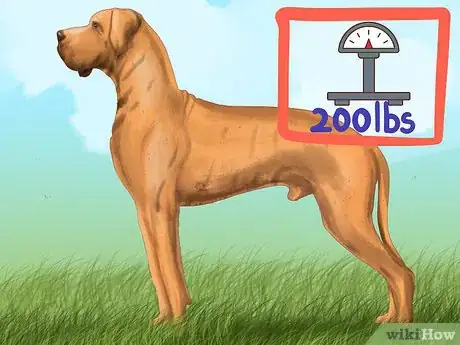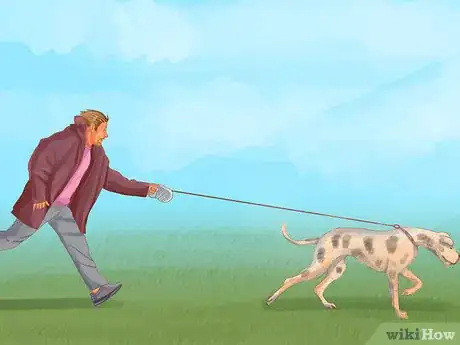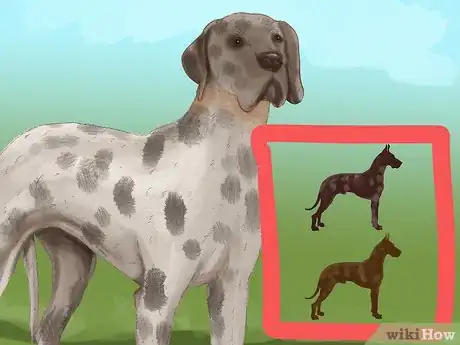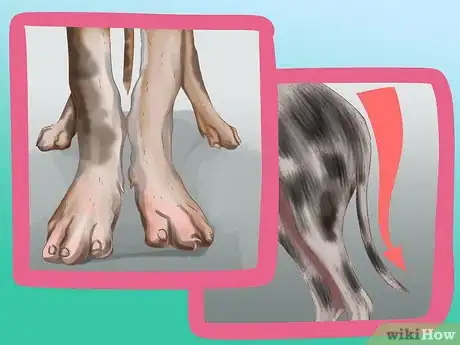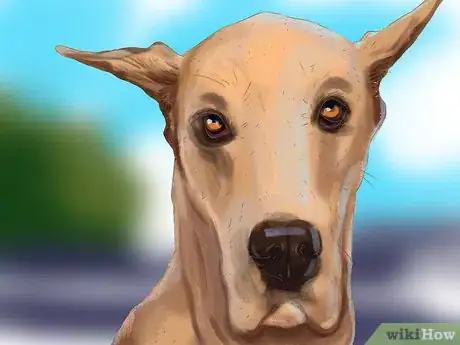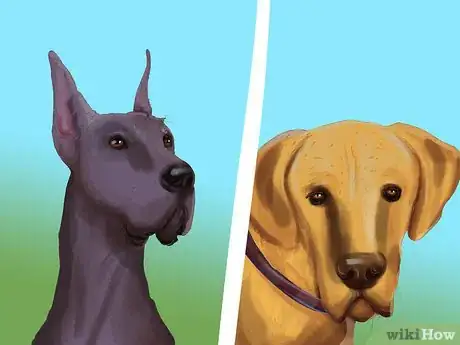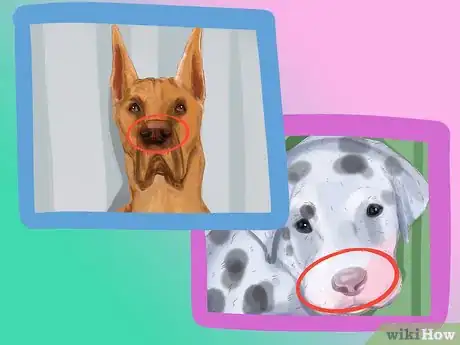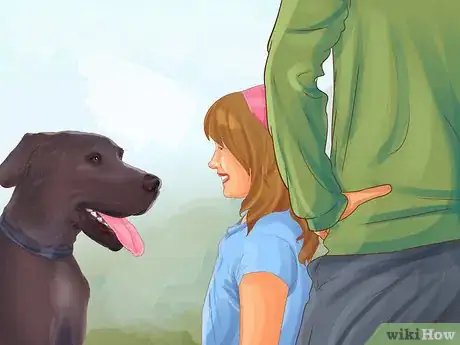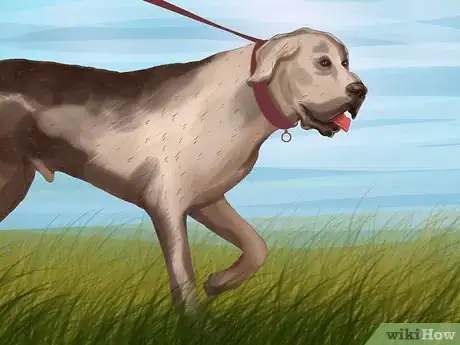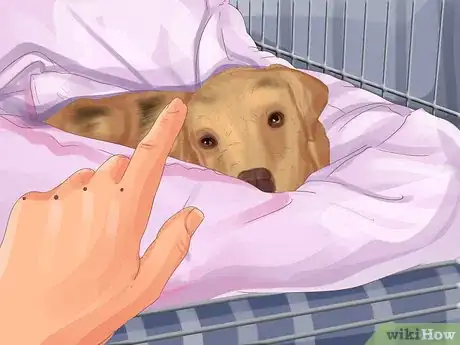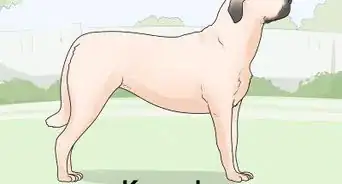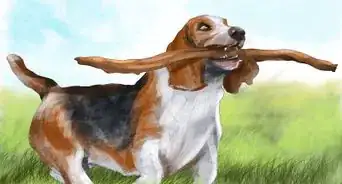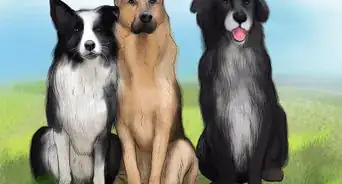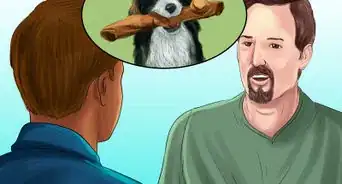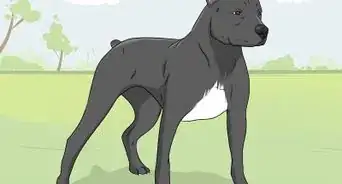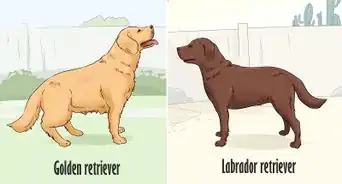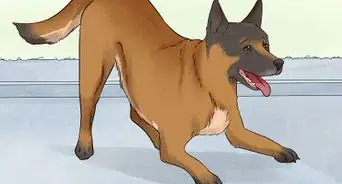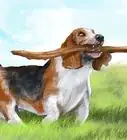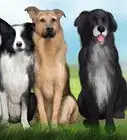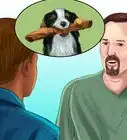This article was co-authored by David Schmucker. David Schmucker is a Dog Trainer and a Senior Trainer at Sidewalk Dog Training in Washington D.C. With over 17 years of experience, David specializes in canine training programs such as dog aggression training, dog behavioral correction, and dog separation anxiety training. David holds a BS in Personnel & Labor Management from the University of Maryland.
There are 13 references cited in this article, which can be found at the bottom of the page.
This article has been viewed 50,242 times.
Great Danes are large, imposing dogs that are one of the tallest dog breeds, second only to the Irish wolfhound.[1] Great Danes were originally bred from mastiffs and greyhounds to hunt wild boar, but now their calm and affectionate personalities have earned them the nickname “gentle giant.” Great Danes can be recognized by their impressive size, their strong and rectangular features, and their warm, playful demeanors.
Steps
Noticing a Great Dane’s Body Build
-
1Note the dog’s size. A Great Dane’s most notable and outstanding feature is its size. This breed can grow to stand around 36 inches (91 cm) and weigh up to 200 lbs (90 kg). These dogs grow quickly during puppyhood and reach maturity around age two or three.[2]
-
2Look at the dog’s large head. Great Danes have massive heads that are long and rectangular. The line of its muzzle and the line of the top of its skull are almost parallel, which gives the dog a regal, distinguished appearance.Advertisement
-
3Pay attention to the dog’s athletic stature. Great Danes have powerful, sleek bodies that are typical in giant working breeds. To identify a Great Dane, look to see that its neck is high set, long, and narrow. Notice that is has a square frame with a broad chest and strong legs. [3]
-
4Observe the dog’s color and markings. A Great Dane has a short, glossy coat that comes in a variety of colors and patterns. The American Kennel Club recognizes nine colors and three patterns. Great Danes have black or white markings throughout their coat, or you may observe that they may have a black mask across their face.[4]
- Some Great Danes are black, black and white, or white. Dogs with a mantle coat have black coats with a white base coat.[5]
- Great Danes can have fawn coats, which are a lighter brown or tan.
- Some have speckled or striped coats. These coats include harlequin, merle, and brindle coats.
- A Great Dane can also have a silver-toned coat, which is categorized as a blue coat.[6]
-
5Study the legs and paws. Great Danes have large paws with well-arched toes that can be the size of an average man’s hand when fully splayed.[7] Its front legs are straight and long, while its hind legs are muscular and broad.
- Notice its tail, too. A Great Dane has a thick, medium-length tail that tapers downward toward its hind legs.
-
6Identify a puppy by its size. A Great Dane puppy weighs between 5 to 8 lbs (2.2 to 3.6 kg), but it does not stay small for long. This breed quickly grows within the first year, and you may notice that a rapid growth spurt can occur overnight. Expect to see a puppy grow to 100 lbs (45 kg) during the first six months.
- You will be able to recognize a Great Dane puppy by looking at its over-sized paws. A younger Great Dane will not have grown into its paw size, so they may appear too big for its smaller frame.
Paying Attention to the Facial Features
-
1Notice the eyes. Great Danes often have almond-shaped, medium-sized, and deep-set eyes. Some Great Danes have slanted eyes or rounded eyes with ectropion, or a drooping lower eyelid.[8] Most eyes are dark or light brown, but blue eyes can be found in Great Danes with a harlequin or blue coat.
-
2Look for pointed or floppy ears. You may notice that some Great Danes have floppy ears. Some breeders crop the outer portions of a dog’s ears to give them a distinctive look, and some argue it helps reduce ear infections.[9] Whether they are cropped or not, most Great Danes have high set, medium-sized ears.
-
3Check the nose color. Most full-grown Great Danes have a black nose, but this can vary depending on the dog’s coat. A dog with a blue coat will often have a dark blue-black nose, and a dog with a harlequin coat may have a spotted nose.[10]
- Great Dane puppies that have a harlequin coat may have a pink nose.[11]
Assessing a Great Dane’s Temperament
-
1Observe a Great Dane’s gentle nature. The Great Dane is highly dependable, and it quickly bonds with its owners. Many are mild-mannered, easy-going, and affectionate.
- It is important to supervise a Great Dane when young children are around. Although these dogs are typically are good-natured, their large size could cause them to bump into a young child. It is also important to remember that some dogs’ personalities do not conform to breed standards or expectations.
-
2Engage in moderate exercise with a Great Dane. Despite their massive size, Great Danes do not need a lot of exercise. Many are happy to lounge on the couch. However, they do need room to run around outside to play and expel energy. Regular daily walks are usually adequate for this breed.
- Owners should have a fenced in yard for their Great Danes. This will help protect the dog and keep them from running after cats, rabbits, and other animals.
- This breed does not typically jump, so a fence that reaches 6 feet (1.8 m) should be adequate to contain a Great Dane.
-
3Begin training as a puppy. Great Danes want to please their owners, so they can easily learn tricks, be crate trained, and be house-trained.[12] It can be very challenging to control an unruly dog of its size, so it is important to start obedience training when they are young.[13] Because they are strongly people-oriented and strive to please, they often participate in agility courses in a variety of dog competitions.
Expert Q&A
Did you know you can get expert answers for this article?
Unlock expert answers by supporting wikiHow
-
QuestionAre Great Danes smart?
 Pippa Elliott, MRCVSDr. Elliott, BVMS, MRCVS is a veterinarian with over 30 years of experience in veterinary surgery and companion animal practice. She graduated from the University of Glasgow in 1987 with a degree in veterinary medicine and surgery. She has worked at the same animal clinic in her hometown for over 20 years.
Pippa Elliott, MRCVSDr. Elliott, BVMS, MRCVS is a veterinarian with over 30 years of experience in veterinary surgery and companion animal practice. She graduated from the University of Glasgow in 1987 with a degree in veterinary medicine and surgery. She has worked at the same animal clinic in her hometown for over 20 years.
Veterinarian
-
QuestionHow much exercise do Great Danes need?
 Pippa Elliott, MRCVSDr. Elliott, BVMS, MRCVS is a veterinarian with over 30 years of experience in veterinary surgery and companion animal practice. She graduated from the University of Glasgow in 1987 with a degree in veterinary medicine and surgery. She has worked at the same animal clinic in her hometown for over 20 years.
Pippa Elliott, MRCVSDr. Elliott, BVMS, MRCVS is a veterinarian with over 30 years of experience in veterinary surgery and companion animal practice. She graduated from the University of Glasgow in 1987 with a degree in veterinary medicine and surgery. She has worked at the same animal clinic in her hometown for over 20 years.
Veterinarian
-
QuestionAre Great Danes good family pets?
 Pippa Elliott, MRCVSDr. Elliott, BVMS, MRCVS is a veterinarian with over 30 years of experience in veterinary surgery and companion animal practice. She graduated from the University of Glasgow in 1987 with a degree in veterinary medicine and surgery. She has worked at the same animal clinic in her hometown for over 20 years.
Pippa Elliott, MRCVSDr. Elliott, BVMS, MRCVS is a veterinarian with over 30 years of experience in veterinary surgery and companion animal practice. She graduated from the University of Glasgow in 1987 with a degree in veterinary medicine and surgery. She has worked at the same animal clinic in her hometown for over 20 years.
Veterinarian
Warnings
- Understand that though Great Danes are gentle and friendly, they may be targeted for banning in some areas due to an intimidating appearance.[14] Make sure to check for any dog bans in your area.⧼thumbs_response⧽
References
- ↑ http://www.animalplanet.com/tv-shows/dogs-101/videos/great-dane/
- ↑ http://www.all-about-great-danes.com/great-dane-growth-chart.html
- ↑ http://images.akc.org/pdf/breeds/standards/GreatDane.pdf?_ga=1.55937576.200684057.1480993933
- ↑ http://www.akc.org/dog-breeds/great-dane/detail/#tone
- ↑ http://www.all-about-great-danes.com/mantle-great-danes.html
- ↑ http://images.akc.org/pdf/breeds/standards/GreatDane.pdf?_ga=1.144105077.1598566972.1486611461
- ↑ http://www.animalplanet.com/tv-shows/dogs-101/videos/great-dane/
- ↑ http://www.pethealthnetwork.com/dog-health/dog-diseases-conditions-a-z/ectropion-dogs-whats-wrong-my-dogs-eyes
- ↑ http://www.petmd.com/dog/care/evr_dg_ear_cropping_is_it_right_for_your_dog
- ↑ http://images.akc.org/pdf/breeds/standards/GreatDane.pdf?_ga=1.144105077.1598566972.1486611461
- ↑ http://www.all-about-great-danes.com/harlequin-great-danes.html
- ↑ http://www.akc.org/dog-breeds/great-dane/detail/
- ↑ http://dogtime.com/dog-breeds/great-dane#/slide/1
- ↑ https://www.yourpurebredpuppy.com/reviews/greatdanes.html
